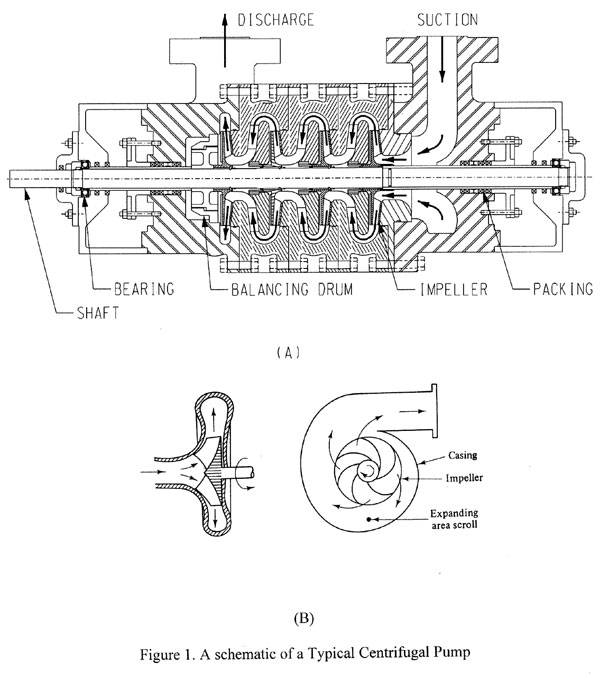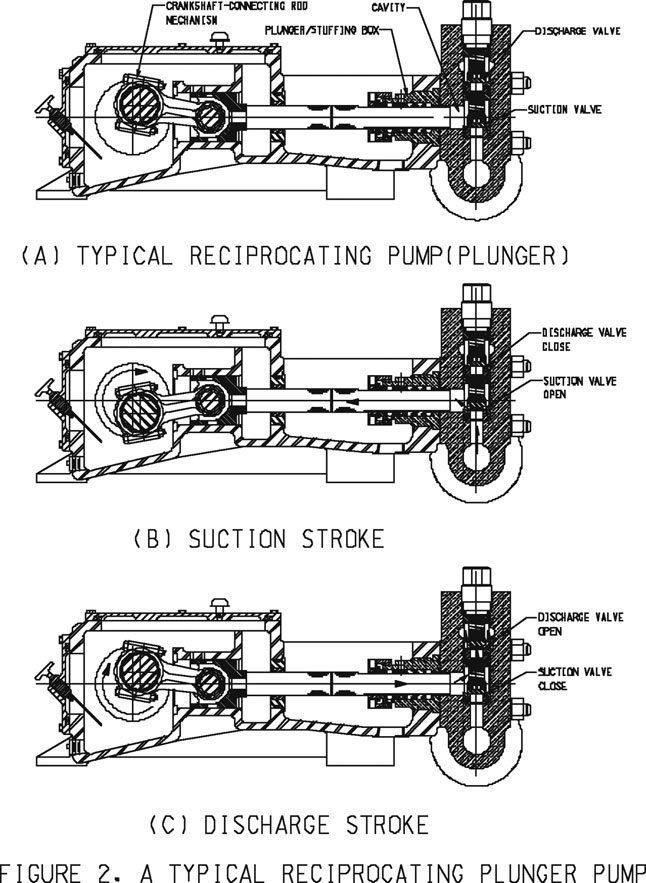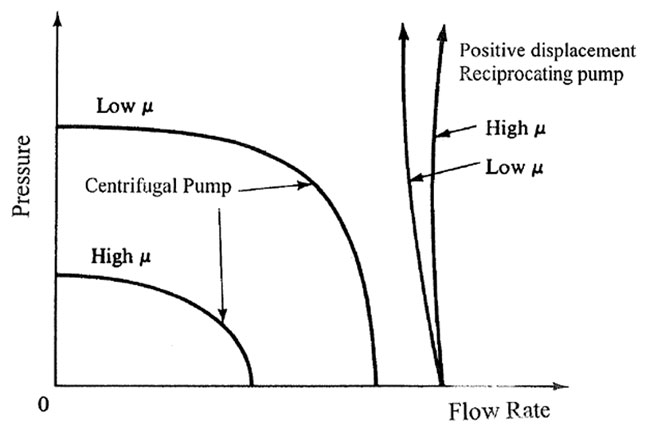Many times, you may be faced with the decision to use a reciprocating pump or a multi-stage centrifugal pump for a given application. There are some pros and cons for either pump design, depending on:
- Where the pump is to be installed
- The fluid being transferred
- Future expansion plans
- Variable system parameters
- Operation and maintenance issues
- Personnel knowledge and experience with the pumps
1. Operating Principles
Centrifugal Pump
A centrifugal pump adds kinetic energy to a fluid by means of fast-rotating impellers. There is no fixed volume, and the fluid increases in kinetic energy (velocity) while moving through impeller passages by centrifugal force resulting from impeller rotation.
Its accelerated velocity is converted into pressure head by exiting into the diffuser for discharge, or – in the case of a multi-stage centrifugal pump – it further increases its velocity (pressure head) by moving through to the next fast-rotating impeller (see Figure 1). Centrifugal pumps are usually direct coupled with drivers (electric motors or engines) without speed reduction.

Reciprocating Pump
A reciprocating pump utilizes a crankshaft-connecting rod mechanism identical to internal combustion engines. The crankshaft-connecting rod mechanism converts the rotary movement of the crankshaft to a reciprocating linear movement of plungers or pistons. The plunger/piston movement creates volume changes.
As a cavity opens when a plunger/piston retracts, the fluid is admitted through an inlet check valve. When the plunger/piston reverses, the inlet check valve closes, and the cavity reduces when the plunger/piston extends. The outlet check valve opens and the fluid is forced out by the plunger/piston.
The discharge volume is fixed for each crankshaft revolution, regardless of the fluid being pumped. Pressure is determined by the system flow resistance and pump construction (see Figure 2). Speed reduction is needed for decreasing high speed from the driver to low pump shaft speed.

2. Capacity and Head (Pressure)
Centrifugal Pump
Since a centrifugal pump has no fixed volume (as indicated above) at a fixed inlet size and casing, increasing the diameter of the impeller or the rotational speed will lead to increased head and increased flow rate.
A centrifugal pump can have a large capacity with a small footprint compared with a reciprocating pump. Of course, increased capacity will consume more energy. Capacity is proportional to impeller speed and diameter. Larger impeller diameter (higher exit velocity) (see Figure 3) and/or faster rotation speed will increase the head due to conversion of velocity to head.
 Figure 3. A typical performance curve of a centrifugal pump.
Figure 3. A typical performance curve of a centrifugal pump.Head is proportional to the square of the impeller diameter or speed. Further increase of head could also result from more stages of impellers. More stages also mean more friction loss between inlet and outlet. This friction loss is what usually limits multi-stage centrifugal pumps to low pressure in comparison with reciprocating pumps. Multistage centrifugals are normally preferred in high volume, low pressure applications.
Reciprocating Pump
Reciprocating pumps produce a fixed discharge volume for each crankshaft rotation, regardless of the fluid being pumped. Increased capacity can be achieved by increasing the plunger/piston diameters or increasing the rotational speed of the crankshaft (energy consumption increases as well).
However, there is limitation because of maximum allowed speed (usually low speed) and the space available with the pump power frame design. As a result, reciprocating pumps have a large foot print with equivalent capacity compared with centrifugal pumps due to its fixed discharge volume.
Reciprocating pumps can be rated at much higher pressures than multi-stage centrifugal pumps. Often a 40,000-psi plunger pump is utilized for higher pressure industrial water blasting. A 10,000-psi to 20,000-psi plunger pump is often seen at oilfields for well service applications. Also, 800-psi to 5000-psi applications for other industrial and oilfield services are common. A typical reciprocating pump performance chart is shown in Figure 4C.
Reciprocating pumps do not generate pressure. The pressure seen at the pump is the result of resistance downstream of the pump discharge. Pressure can be as high as possible, as long as the plunger load is within rated values and the pressure is within the fluid cylinder and piping rated pressures.
In a reciprocating pump, small plungers are rated for higher pressures for a given rated plunger load because the area subjected to the pressure load, the end cross area, is smaller. Discharge pressure is rated for the complete speed range. Usually, speed changes do not affect the pressure rating for a continuous duty application. Reciprocating pumps are normally preferred for lower volume, high pressure applications.
3. Efficiency
Centrifugal Pump
As discussed above, centrifugal pumps transfer fluid by high speed rotating impellers to convert kinetic energy into pressure energy. There are no direct energy transfers. Basically, there are three types of efficiencies to consider: Volumetric, Hydraulic, and Mechanical.
Volumetric efficiency loss is due to leakage in the impeller-pump casing clearance.
Hydraulic efficiency loss is caused by: a) shock loss at impeller eye due to an imperfect match between inlet flow and impeller blade entrances and turbulence; b) friction loss in impeller blade passages; and c) circulation loss due to imperfect match at the exit side of the impeller blades.
Mechanical efficiency loss is the result of mechanical friction in bearings, support bushings, packing gland, and other contact points in the machine.
The overall efficiency on a centrifugal pump normally ranges from 30 percent to 60 percent (see Figure 3) depending on pump design and system operating parameters vs. pump performance parameters. This results from pump over-sizing and considerations of system flow rate/head safety margins when the system is designed or the system operating parameters change.
Efficiencies up to 85 percent can be reached on special designs which operate at BEP (best efficiency point) when pump performance curve and system-operating curve match perfectly. However, because of safety margin considerations regarding the system’s operation, generally the engineer tends to oversize the pump and the system parameters. This often results in the pump operating in a partial-load range at efficiency levels below 30 percent.1
Reciprocating Pump
In regards to the reciprocating pump, there are only two efficiency losses which need to be considered, namely Volumetric and Mechanical.
Volumetric efficiency loss is induced by slippage through valves, ratio of liquid chamber volume at end of stroke to plunger/piston displacement volume, and liquid compressibility.
Mechanical efficiency loss occurs while overcoming mechanical friction in bearing and speed reduction.
The overall efficiency of a reciprocating pump unit is generally above 85 percent throughout its full operating range (see Figure 4). It is not uncommon to see a pump running over 90 percent because many pumps and reduction units operate at a mechanical efficiency of 98 percent, and the volumetric efficiency can often be above 95 percent.

4. Effect of Viscosity
When a centrifugal pump is used for high viscosity fluids, the Reynolds number (a dimensionless number to identify if fluids are turbulent) becomes low turbulent or even laminar. This has a significant effect on performance.2
Figure 5 shows the typical test curves of head and brake horsepower versus flow rate. High viscosity causes a dramatic drop in head and flow rate and increases power requirements.
 Figure 5. The effect of viscosity on centrifugal pump performance.
Figure 5. The effect of viscosity on centrifugal pump performance.Figure 6 also shows an interesting operational difference between reciprocating and centrifugal pumps. The reciprocating pump provides a nearly constant flow rate over a wider range of pressure; the centrifugal pump gives uniform pressure over a range of flow, then it drops dramatically as the flow rate increases. On a reciprocating pump, fluid viscosity has little effect on the flow rate as the pressure increases. However, fluid viscosity has a big impact on the centrifugal pump’s pressure and flow rate.
 Figure 6. Comparison of performance curves of typical centrifugal reciprocating pumps at constant speed.
Figure 6. Comparison of performance curves of typical centrifugal reciprocating pumps at constant speed.The efficiency also drops substantially as shown in the following typical results:
Efficiency of a pump is directly related to energy consumption. It could be expected that the energy costs of a centrifugal pump are typically 1.40 times to 1.90 times that of a reciprocating pump.3 In some instances, this could be as high as 2 times to 3 times if the centrifugal pump operates at below 30 percent efficiency due to the system performance not matching the pump’s performance. Figure 3 shows a typical performance chart. At the same pump speed, there are different pump efficiencies at different operating points. It indicates that for a given impeller diameter, as the flow output is increased the pump head decreases. Alternatively, if the pump head needs to be increased, discharge flow rate is sacrificed. Reciprocating Pump
Figure 8 shows a typical performance chart. If the pump speed is unchanged, the pump flow rate will be constant, regardless of the system’s resistance. For comparative purposes, we will consider the same conditions as discussed above. A. More head is required because components fail or required pressure increases (see Figure 8A). In such a case, there is nothing needed to be done as soon as the pressure is within the rated pressure. HP requirements will increase and motor overload could occur.5. Energy Consumption
6. Performance
Centrifugal Pump

B. Actual system pump resistance is less than designed. As shown on Figure 7B, the design operating point is “A,” and when the pump is placed in operation the system resistance is less than what has been expected and, consequently, the pump will operate at “D.” The result is that the pump will operate at lower pressure and consume less energy.
C. Design safety factor is used. It is often desirable to select a pump with safety factor to meet worst-case scenario operating conditions with a safety margin on flow rate and pressure. As shown on Figure 8C, the system is estimated to operate in “E.” A safety margin for flow rate and pressure “A” is used to select a pump.
When the pump is placed in operation, it is found out that the estimation is incorrect and the pump operates at “G.” To have pump operate at “E,” a control valve has to be used to bypass unwanted flow (QA-QE), thereby resulting in an operating point at “F.”
7. Pump Characteristics
Centrifugal PumpRefer to Figure 1. A centrifugal pump consists of an impeller rotating within a casing. Liquid directed into the center of the rotating impeller is picked up by the impeller vanes, accelerated to a higher velocity by the rotation of the impeller, and discharged by centrifugal force into the casing and out the discharge.
When the liquid in the impeller is forced away from the center of the impeller, a low pressure zone is created at the impeller eye and consequently more liquid flows into the pump. Therefore, a steady flow through the impeller is produced unless something happens to disrupt the low pressure zone at the inlet or disrupt the flow to the center of the impeller, unless the flow at the discharge is restricted by a pressure greater than the pressure head developed by the rotating impeller.
Reciprocating Pump
The reciprocating pump does not generate head. Instead, the pump converts rotating motion and torque into linear motion and force (see Figure 2), generating variable flow at the discharge connection.
The system’s resistance to flow generates head. Hence, the pump will draw upon available power and energy until it overcomes all flow resistances downstream. If excessive flow restrictions exist, the pump can be over pressurized, and the driver may stall or the weakest link in the system can fail. Therefore, it is imperative that a safety relief valve is installed in the system.
Because of the conversion of rotation to linear motion, flow varies within each pump revolution.
Total flow variation for the triplex reciprocating is 23.0 percent, while flow variation for the quintuplex pump is only 7.1 percent. Flow variation will cause pressure to fluctuate, considering most fluids are perceived incompressible. Therefore, it is generally recommended that a pulsation suppression device be installed in the pump suction and discharge line to avoid excessive piping vibration.
8. Maintenance
Centrifugal Pump Usually maintained components are fluid end parts and shaft packing or mechanical seals. Some of these items are field repairable, but often companies will send the equipment to an authorized repair facility for maintenance or overhaul. Because of tight tolerances and fast rotating assemblies, most designs do not accommodate fluids laden with solids, which could accelerate wear. Reciprocating PumpPlunger packing, plunger (piston on piston pump), and suction/discharge valves are expendable parts in a reciprocating pump. They are field repairable. A trained mechanic can perform the job easily. The frequency between change outs depends on pump speed, materials used, and fluid pumped.
Conclusion
The centrifugal pump and the reciprocating pump are discussed in regards to their operating principle, efficiency, effect of viscosity, energy consumption, performance, pump characteristics, and maintenance. The above factors are summarized in the following table:
A decision can be made by examining the needs pertaining to the pumping system, initial investment, operating cost, maintenance, and personnel’s knowledge about pumps.
References
- Gunnar Hovstadius, “Life-cycle Strategy for Pumps Improves Cost Structure,” World Pumps, February 2001.
- Frank White, Fluid Mechanics, second edition, McGraw-Hill, Inc., 1986.
- Stephen Smith, “Twin-Screw Pumps vs. Centrifugal and Reciprocating Pumps,” Pumps & Systems, November 2000.
- Doug Kriebel, “Key Centrifugal Pump Parameters and How They Impact Your Applications – Part 2,” Pumps & Systems, October 2000, 1996.
- C. C. Heald, Cameron Hydraulic Data, Eighteenth edition, Ingersoll-Dresser Pumps.
- Hydraulic Institute Standards, 14th edition, 1983.
